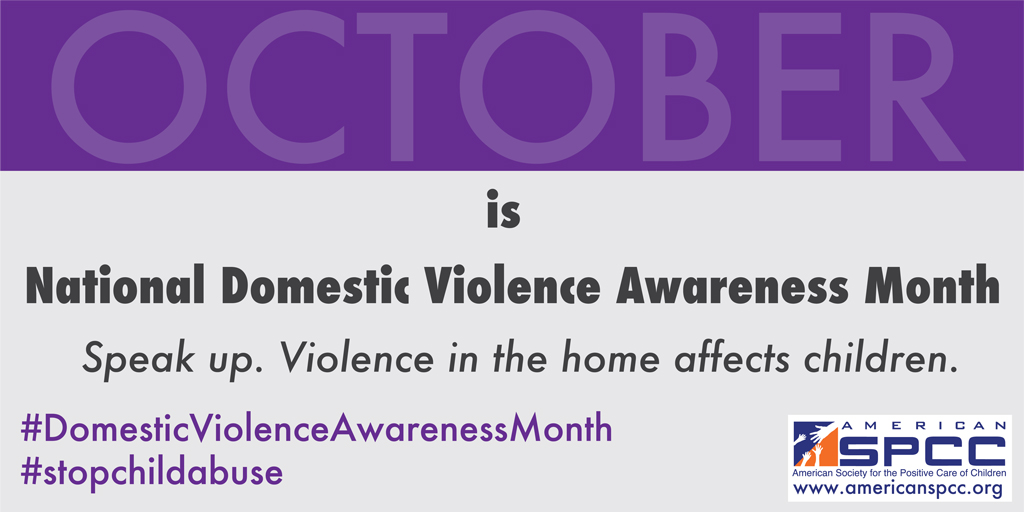A Note from American SPCC:
Each year, millions of children and adolescents in the United States are exposed to violence in their homes, schools, and communities as both victims and witnesses. Even if they are not physically present, children may be affected by intentional harm done by another (for example, the murder of or an assault on a family member or close neighbor).
American Society for the Positive Care of Children joins Domestic Violence Awareness month to advocate and work to end domestic violence in America. American SPCC encourages parents, caregivers, teachers and society members to recognize the signs, indicators, and serious consequences that domestic violence has on young children, and learn what you can do to help those affected.[/vc_column_text][vc_separator border_width=”2″][vc_column_text]promising.futureswithoutviolence.org
All children and youth who live with domestic violence are affected by the experience. The nature and extent of the effects vary greatly. Some children are severely traumatized while others are able to cope well, and go on to live healthy, productive lives.
Children are not just eye witnesses to domestic violence. They are actively involved in trying to understand the abuse, predict when it will happen, protect themselves, their mother or their siblings and worrying about the consequences. Fear and secrecy dominate family relationships, and survival becomes the primary goal of non-abusing family members. The focus on making it through each day may leave little room for fun and relaxation, meeting basic needs or planning for the future.
Children are exposed to domestic violence in many different ways:
Seeing mother threatened, demeaned or battered
Being in the middle of an assault by accident, because the abuser intends it, or because the child tries to intervene
Overhearing conflict and battering
Seeing the aftermath, such as mother’s injuries and trauma reactions
Living in a household dominated by tension and fear
Being raised by parents whose ability to care for them is compromised by domestic violence
Being used and manipulated by the abuser to hurt the battered parent
Suffering the consequences of economic abuse
Effects of exposure to domestic violence can include:
Believing the abuse is their fault
Turning against mother or father or having ambivalent feelings about both parents
Feeling that they are alone, that there is no one who understands them
Being afraid to talk about the abuse or express their feelings
Developing negative core beliefs about themselves and others
Developing unhealthy coping and survival reactions, such as mental health or behavior problems
Believing that the world is a dangerous and unpredictable place
Being isolated from people who might find out about the abuse or offer help
Children and youth also learn lessons such as:
Violence and coercion are normal and justifiable.
Abusive tactics are effective ways of getting what you want.
There are two ways to solve problems: aggression and passivity.
Victims are responsible for what happens to them.
People who hurt others don’t face consequences for their actions.
It’s OK to blame problems on someone else.
People who are supposed to take care of you cannot always be trusted.
Women are not worthy of respect.
Teenagers (13–18 years)
Older children may exhibit the most behavioral changes as a result of exposure to violence. Depending on their circumstances, teenagers may:
Talk about the event all the time or deny that it happened
Refuse to follow rules or talk back with greater frequency
Complain of being tired all the time
Engage in risky behaviors
Sleep more or less than usual
Increase aggressive behaviors
Want to be alone, not even wanting to spend time with friends
Experience frequent nightmares
Use drugs or alcohol, run away from home, or get into trouble with the law
Witnessing domestic violence can have negative effects on children’s development. Exposure to domestic violence, like other toxic stressors, can interfere with a child’s healthy brain development. This can lead to altered stress response, difficulty paying attention, hyper-startle response, and other problems. The potential symptoms childhood exposure to domestic violence can be characterized as externalized or internalized symptoms. Externalized symptoms are more visible and often manifest as behavioral problems. Internalized symptoms are less visible and more likely to be characterized as mental health problems.
Externalized symptoms of children’s exposure to domestic violence include:
Aggression
Lower social competence, including less empathy with others
Lower verbal, cognitive and motor abilities
Restlessness, impulsivity and difficulty concentrating
Behavioral and academic difficulties in school
Immaturity, delays in development and regression to earlier developmental stages
Internalized symptoms of children’s exposure to domestic violence include:
Depression, anxiety and hyper-vigilance
Fearful, withdrawn and inhibited behavior
Lower self esteem
Shame and feeling responsible for the abuse
Post Traumatic Stress Disorder
Long term effects of exposure to domestic violence include a higher risk for alcohol and drug abuse, sexual acting out, running away, and suicide. Boys who grow up with domestic abuse are more likely to abuse their intimate partners, and girls are less likely to seek help if they become victims in their adult relationships.
This information was developed by the Wisconsin Coalition Against Domestic Violence and reprinted with their permission.
EFFECTS OF DOMESTIC VIOLENCE: Children and Youth Exposed to Domestic Violence

Parenting Toolkits
Learning offline is now possible! Download our new Parenting Toolkits today.
